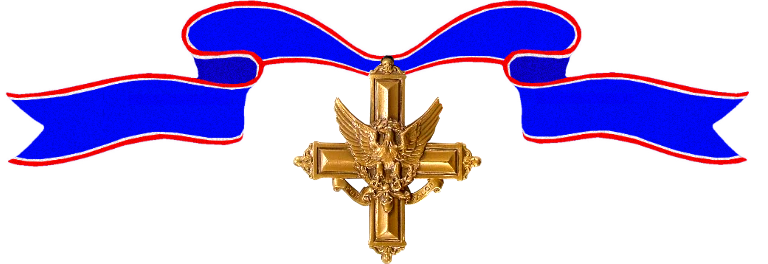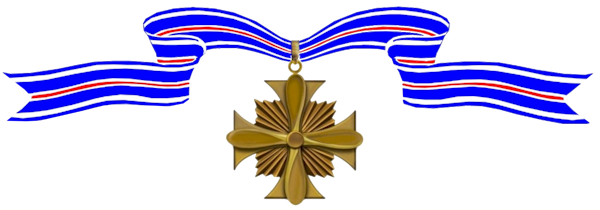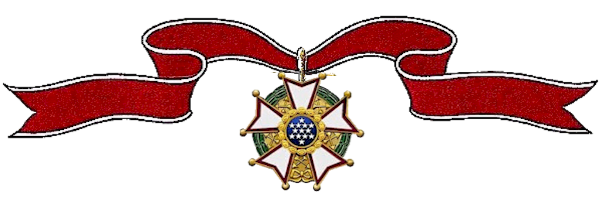The President of the United States of America, under the provisions of the Act of Congress approved July 9, 1918, takes pleasure in presenting the Distinguished Service Cross (Air Force) to Captain Ralph Sherman Parr (AFSN: 0-28206), United States Air Force, for extraordinary heroism in connection with military operations against an armed enemy of the United Nations while serving as Pilot of an F-86 Sabrejet Figher of the 334th Fighter-Interceptor Squadron, 4th Fighter-Interceptor Group, FIFTH Air Force, in action against enemy forces in the Republic of Korea on 30 June 1953. On that date, while leading a formation of two F-86 type aircraft on a combat air patrol deep in enemy territory, Captain Parr was attacked by a formation of ten enemy MiGs. Exhibiting superb airmanship and extraordinary gallantry, Captain Parr positioned himself on the attackers. Despite the imminent threat from the hail of cannon fire from behind, Captain Parr selected his target, and with a long burst from his guns, destroyed one of the enemy MiGs. Against superior numbers of enemy aircraft, Captain Parr, although under a continual hail of enemy cannon fire, and with complete disregard for his personal safety, again valiantly counter-attacked another of the threatening aircraft. Utilizing extraordinary flying skill, Captain Parr tenaciously followed the enemy through a series of violent, evasive maneuvers until he gained the advantage and scored multiple hits on the MiG, causing it to burst into flame. While turning to move to surprise another of the enemy aircraft, Captain Parr broke off his attack to answer a call of distress from a friendly aircraft. Although dangerously low on fuel, Captain Parr, at great risk to his life, provided aggressive and determined protection for the distressed friendly aircraft, escorting it safely back to base. Captain Parr’s keen flying skill in turning the tide of battle despite overwhelming odds and his high personal courage in protecting a fellow pilot evidenced conspicuous gallantry in action, and reflected great credit upon himself, the Far East Air Forces and the United States Air Force.

Awards Received
-

Distinguished Flying Cross
-

Distinguished Flying Cross
-

Distinguished Flying Cross
-

Distinguished Flying Cross
-

Distinguished Flying Cross
-

Distinguished Flying Cross
-

Distinguished Flying Cross
-

Distinguished Flying Cross
-

Distinguished Flying Cross
-

Legion of Merit
-
Distinguished Flying Cross
Service:
United States Air ForceRank:
CaptainBatallion:
334th Fighter-Interceptor SquadronRegiment:
4th Fighter-Interceptor WingDivision:
5th Air ForceAction Date:
June 7, 1953
The President of the United States of America, authorized by Act of Congress, July 2, 1926, takes pleasure in presenting a Third Bronze Oak Leaf Cluster in lieu of a Fourth Award of the Distinguished Flying Cross to Captain Ralph Sherman Parr (AFSN: 0-28206), United States Air Force, for extraordinary achievement while participating in aerial combat against the enemies of the United Nations in Korea, on 7 June 1953, as pilot of an F-86 aircraft, 4th Fighter Interceptor Wing, FIFTH Air Force. On this day, Captain Parr was flying number four man in a four-ship flight deep within enemy-held territory when he sighted two enemy MiG’s far below his flight. Captain Parr saw that he was the only aircraft in the flight that had a tactical advantage on the enemy aircraft, and received permission from his element leader to attack the MiG’s. Captain Parr rolled over into a vicious diving attack and began firing on the MiG’s. During the battle, Captain Parr’s gunsight ceased to function, but without the gunsight Captain Parr still managed to destroy one of the MiGs and damage the other MiG. Captain Parr was then attacked by six more MiGs who had observed the battle. Captain Parr broke hard to the left as the lead MiG of the attacking force opened fire on him, and began a series of violent maneuvers to elude the attacking MiGs. The lead MiG tried to turn inside of Captain Parr on the initial break and in doing so lost control of his aircraft and was seen to snap and enter a spin near the ground. The MiG pilot ejected just before his aircraft hit the ground and exploded. Captain Parr was credited with the destruction of two MiGs and the damage of one MiG on this mission. This action is an example of the outstanding courage and exceptional flying and tactical abilities of Captain Parr, which brought great credit upon himself, the United Nations and the United States Air Force.
-
Distinguished Flying Cross
Service:
United States Air ForceRank:
CaptainBatallion:
334th Fighter-Interceptor SquadronRegiment:
4th Fighter-Interceptor WingDivision:
5th Air ForceAction Date:
July 12, 1953
The President of the United States of America, authorized by Act of Congress, July 2, 1926, takes pleasure in presenting a Fourth Bronze Oak Leaf Cluster in lieu of a Fifth Award of the Distinguished Flying Cross to Captain Ralph Sherman Parr (AFSN: 0-28206), United States Air Force, for extraordinary achievement while participating in aerial flight on 12 July 1953 in aerial combat against an enemy of the United Nations in Korea while piloting an F-86 aircraft of the 4th Fighter Interceptor Wing, FIFTH Air Force. While leading a two-ship flight of F-86’s on a combat air patrol in North Korea, Captain Parr sighted a formation of four enemy MiG-15’s crossing the Yalu to the South using a low cloud cover for concealment. Immediately initiating a high speed diving maneuver, Captain Parr dived through the overcast to attack, as he closed to fire, two of the enemy aircraft evaded him by crossing the Yalu. The two remaining enemy MiG’s turned hard into Captain Parr’s attack, but through superior skill he maneuvered his aircraft into attacking position and brought his guns to bear on one of the MiG’s, scoring multiple hits in the engine section with several bursts of his deadly fire. The MiG began burning fiercely and desperately tried to escape, but Captain Parr tenaciously pursued the MiG firing all the while. After scoring more hits on the enemy aircraft, the pilot was observed to eject and his flaming aircraft crashed into the ground. Upon return to his home base, Captain Parr was officially credited with the destruction of one MiG-15. This action exemplifies the courage, superior skill, and aggressive airmanship displayed by Captain Parr throughout his combat tour, and reflect great credit upon himself and the United States Air Force.
-
Distinguished Flying Cross

Headquarters, 7th Air Force, Special Orders No. G-1423 (May 15, 1968)The President of the United States of America, authorized by Act of Congress, July 2, 1926, takes pleasure in presenting a Silver Oak Leaf Cluster in lieu of a Sixth Award of the Distinguished Flying Cross to Colonel Ralph Sherman Parr (AFSN: 0-28206), United States Air Force, for extraordinary achievement while participating in aerial flight as an F-4C Aircraft Commander in Southeast Asia on 14 November 1967. On that date, Colonel Parr led a mission over South Vietnam, against hostile ground forces engaged in combat with United States Army personnel in an outnumbered balance of troops. With complete disregard for his own personal safety, operating under marginal weather conditions and in the face of intense ground fire, Colonel Parr made multiple passes inflicting major damage. The professional competence, aerial skill and devotion to duty displayed by Colonel Parr reflect great credit upon himself and the United States Air Force.
-
Distinguished Flying Cross

Headquarters, 7th Air Force, Special Orders No. G-2035 (July 9, 1968)The President of the United States of America, authorized by Act of Congress, July 2, 1926, takes pleasure in presenting a Bronze Oak Leaf Cluster in addition to a previously awarded Silver Oak Leaf Cluster in lieu of a Seventh Award of the Distinguished Flying Cross to Colonel Ralph Sherman Parr (AFSN: 0-28206), United States Air Force, for heroism in connection with military operations against an opposing armed force as an F-4C Aircraft Commander in Southeast Asia on 6 November 1967. On that date, Colonel Parr led a mission in close support of friendly forces struggling to defend the Dak To Special Forces Camp. Under intense hostile automatic weapons fire, Colonel Parr made multiple passes, delivering his ordnance with such devastating accuracy that the hostile elements were forced to make an unorganized withdrawal leaving much of their equipment behind. The outstanding heroism and selfless devotion to duty displayed by Colonel Parr reflect great credit upon himself and the United States Air Force.
-
Distinguished Flying Cross

Headquarters, 7th Air Force, Special Orders No. G-3239 (July 17, 1970)The President of the United States of America, authorized by Act of Congress, July 2, 1926, takes pleasure in presenting a Third Bronze Oak Leaf Cluster in addition to a previously awarded Silver Oak Leaf Cluster in lieu of a Ninth Award of the Distinguished Flying Cross with Combat “V” to Colonel Ralph Sherman Parr (AFSN: 0-28206), United States Air Force, for heroism while participating in aerial flight as an Aircraft Commander near Dak To, Republic of Vietnam, on 13 April 1970. On that date, Colonel Parr led a flight of two F-4D’s on an aerial strike mission in support of the besieged Special Forces who had been virtually overrun by a hostile force in excess of battalion strength. Despite the continuous barrage of hostile anti-aircraft, automatic weapons, and small arms fire, and with complete disregard for his personal safety, Colonel Parr attacked the well entrenched hostile forces, making multiple passes and delivering at point blank range to assure target destruction and avoid the friendly positions. As a direct result of Colonel Parr’s actions, the hostile force was annihilated and the stronghold was recaptured by the friendly forces, only hours after this air strike. The outstanding heroism and selfless devotion to duty displayed by Colonel Parr reflect great credit upon himself and the United States Air Force.
-
Distinguished Flying Cross

The President of the United States of America, authorized by Act of Congress, July 2, 1926, takes pleasure in presenting a Fourth Bronze Oak Leaf Cluster in addition to a previously awarded Silver Oak Leaf Cluster in lieu of a Tenth Award of the Distinguished Flying Cross to Colonel Ralph Sherman Parr (AFSN: 0-28206), United States Air Force, for extraordinary achievement while participating in aerial flight as an F-4D Aircraft Commander near Pleiku Air Base, Republic of Vietnam, on 18 May 1970. On that date, Colonel Parr led a flight of two fighter aircraft in attacking an extremely dangerous hostile location. His expert tactical planning and extremely accurate ordnance delivery inflicted ten casualties on the hostile force and destroyed twenty-five military structures. The professional competence, aerial skill, and devotion to duty displayed by Colonel Parr reflect great credit upon himself and the United States Air Force.
-
Distinguished Flying Cross
Service:
United States Army Air ForcesRank:
CaptainBatallion:
334th Fighter-Interceptor SquadronRegiment:
4th Fighter-Interceptor WingDivision:
5th Air ForceAction Date:
World War II
(Citation Needed) – SYNOPSIS: Captain Ralph Sherman Parr (AFSN: 0-28206), United States Army Air Forces, was awarded the Distinguished Flying Cross for extraordinary achievement while participating in aerial flight.
-
Distinguished Flying Cross
Service:
United States Air ForceRank:
CaptainRegiment:
4th Fighter-Interceptor WingDivision:
5th Air ForceAction Date:
June 10, 1953
The President of the United States of America, authorized by Act of Congress, July 2, 1926, takes pleasure in presenting a Bronze Oak Leaf Cluster in lieu of a Second Award of the Distinguished Flying Cross to Captain Ralph Sherman Parr (AFSN: 0-28206), United States Air Force, for extraordinary achievement while participating in aerial flight on 10 June 1953, in aerial combat against enemies of the United Nations in Korea, as pilot of an F-86 aircraft, 4th Fighter Interceptor Wing, FIFTH Air Force. On this day, Captain Parr was flying in a flight of four F-86’s on a patrol deep within North Korea. As they neared the Yalu River, Captain Parr’s flight was attacked by a large force of MiG’s and split up into elements of two, but he and his wingman evaded the MiG’s in the break. Captain Parr then observed two more MiG’s heading for the Yalu River, using clouds for concealment. He and his wingman headed for them in a high speed dive. Captain Parr broke out of the clouds on the MiG’s at a very close range, and although he was having trouble controlling his aircraft due to the high speed, he nevertheless opened fire, placing a concentrated burst of fire into the MiG’s engine section. The MiG was observed to explode. Although Captain Parr’s aircraft sustained damage from parts of the enemy aircraft flying back, he was able to control his aircraft, and upon returning safely to his home base, was credited with the destruction of one MiG-15. This action is typical of the outstanding courage and exceptionally aggressive flying ability of Captain Parr, and reflects great credit upon himself and the United States Air Force.
-
Distinguished Flying Cross
Service:
United States Air ForceRank:
CaptainBatallion:
334th Fighter-Interceptor SquadronRegiment:
4th Fighter-Interceptor WingDivision:
5th Air ForceAction Date:
June 19, 1953
The President of the United States of America, authorized by Act of Congress, July 2, 1926, takes pleasure in presenting a Second Bronze Oak Leaf Cluster in lieu of a Third Award of the Distinguished Flying Cross to Captain Ralph Sherman Parr (AFSN: 0-28206), United States Air Force, for extraordinary achievement while participating in aerial flight on 19 June 1953, in aerial combat against enemies of the United Nations in Korea, as pilot of an F-86 aircraft, 4th Fighter Interceptor Wing, FIFTH Air Force. On this date, Captain Parr was leading a flight of four F-86’s flying protective cover for a slow flying reconnaissance aircraft when the RF-80 was attacked by an enemy MiG-15. As the MiG pulled up to fire on the unarmed RF-80, Captain Parr attacked the enemy MiG, and closing to 1,5009 feet, fired a long burst directly into the MiG’s fuselage. The MiG immediately caught fire, and just before it spun into the ground and crashed, the pilot was observed to eject. At this time another MiG-15 attacked the reconnaissance aircraft, and Captain Parr again initiated another vicious attack. He closed to 1,800 feet range and fired several bursts at the enemy aircraft, scoring multiple hits and causing the enemy to break off the attack on the RF-80. Captain Parr then escorted the reconnaissance aircraft to his remaining targets and back to friendly territory safely. Upon return to his home base, Captain Parr was officially credited with destroying one MiG-15 and damaging another. This action is another example of the outstanding flying ability and fearless courage of Captain Parr, and reflects great credit upon himself and the United States Air Force.
-
Legion of Merit
Service:
United States Air ForceRank:
ColonelAction Date:
January 30, 1974 – August 15, 1976
The President of the United States of America, authorized by Act of Congress, July 2, 1926, takes pleasure in presenting a Second Bronze Oak Leaf Cluster in lieu of a Third Award of the Legion of Merit to Colonel Ralph Sherman Parr (AFSN: 0-28206), United States Air Force, for exceptionally meritorious conduct in the performance of outstanding services to the Government of the United States as Director of Operations, United States Air Force Tactical Air Warfare Center, Tactical Air Command, and as Chief of Staff, Armament Development and Test Center, Air Force Systems Command, Eglin Air Force Base, Florida, from 30 January 1974 to 15 August 1976. With extraordinary professionalism and personal dedication, Colonel Parr applied the highest standards of executive management in both highlighting and solving problems involving Center efforts of national importance. His personal ability, diligence, and devotion to duty contributed immeasurably to the successful accomplishment of the Air Force mission. The singularly distinctive accomplishments of Colonel Parr culminate a long and distinguished career in the service of his country, and reflect great credit upon himself and the United States Air Force.

